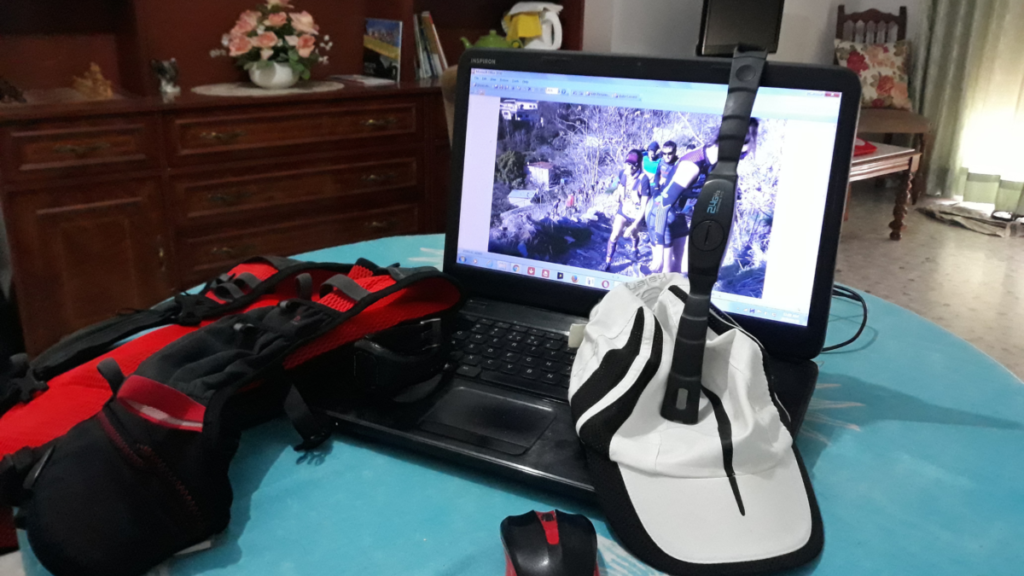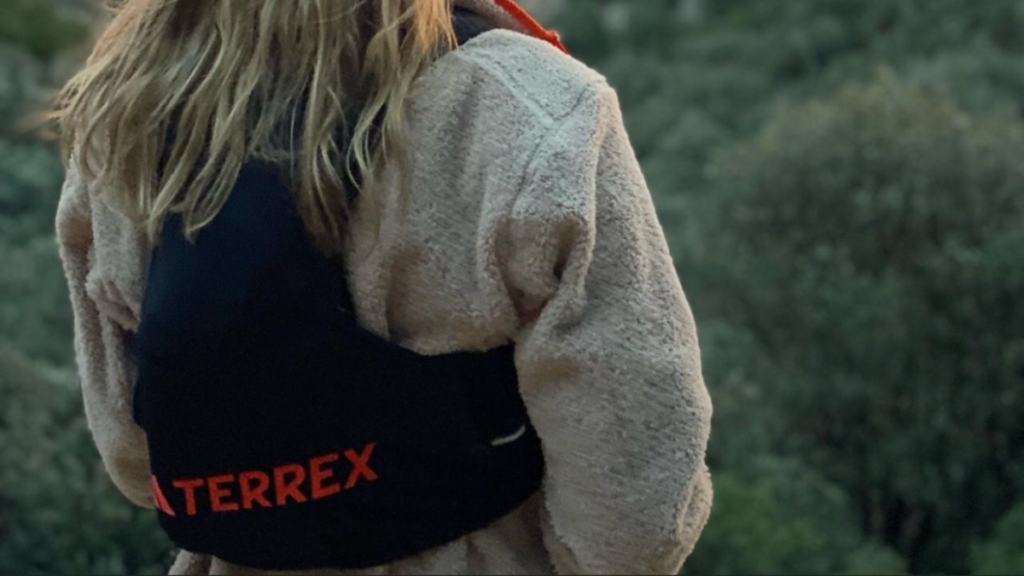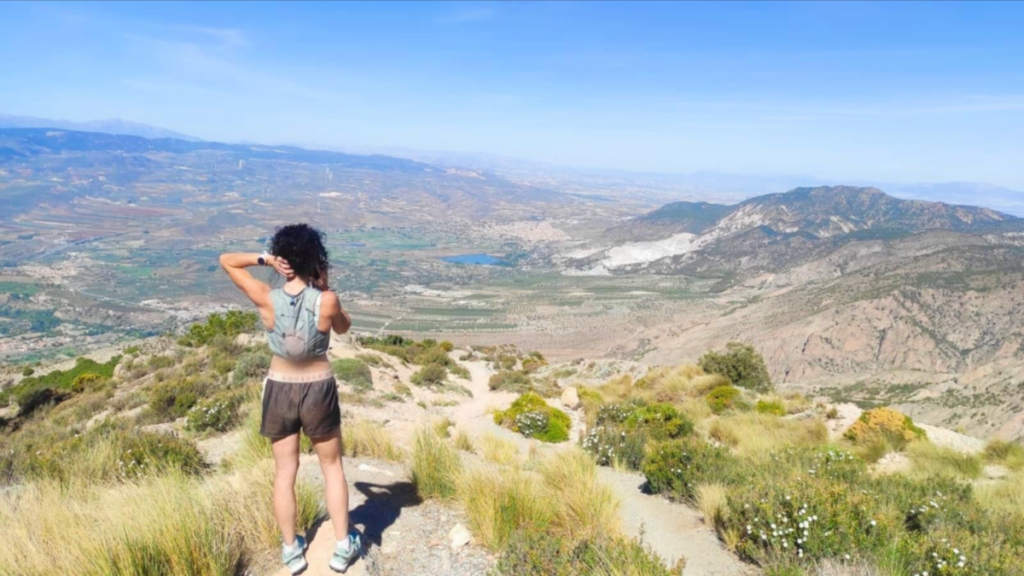
Over the years I have had my fair share of exciting adventures in the mountains. After each one of those adventures I would add a new item to my list of essential gear that I’d pack for a trip into the mountains. Luckily for you, my misadventures and epic struggles has taught me what you should pack when you head out trail running so that you can stay safe.
Beyond shoes, comfortable clothing, and hydration trail running beginners need to pack essential safety gear every time they head into the mountains. This includes a head torch, first aid kit, survival blanket, a whistle, and a means of communicating in the event of a mountain emergency.
Let’s take a closer look at the items that should be on your essential gear list for trail running so that you can enjoy the trails and be prepared for most of the mishaps that might cross your path.
The Essential Gear for Trail Running Beginners
Trail running beginners require essential gear to ensure a safe and enjoyable experience on the trails. One crucial piece of gear is a reliable pair of trail running shoes, providing the necessary traction and stability to navigate rugged terrain comfortably. Additionally, hydration is key, with options like water bottles or hydration packs to keep runners hydrated during their adventures.

Another essential gear category is navigational tools, such as GPS watches and trail maps, to help beginners stay on course and explore new trails confidently. Apparel plays a vital role, with moisture-wicking clothing keeping runners dry and comfortable in various weather conditions.
Protective gear like sunglasses, sunscreen, and insect repellent are essential for trail runners to shield themselves from the sun and bugs. Nutrition is also crucial, with energy gels, bars, and hydration supplements providing the necessary fuel for long runs.
First aid essentials like bandages, blister kits, and emergency whistles should not be overlooked for safety. Reflective gear and personal identification help ensure visibility and preparedness on the trails. Lastly, weather preparedness gear like waterproof clothing and layering techniques are vital for tackling changing weather conditions.
Choosing the Right Trail Running Shoes
When choosing the right trail running shoes, it’s essential to consider several key factors to enhance your trail running experience. Traction is a critical aspect to prevent slips and falls on uneven terrain, providing you with the stability needed to navigate challenging paths confidently. Opt for shoes with aggressive lugs and durable outsoles to grip various surfaces effectively.
Stability is another crucial factor to prevent ankle twists and injuries while running on rocky or root-covered trails. Look for shoes with a supportive midsole and secure heel counter to maintain stability on unpredictable terrain. Additionally, the fit of your trail running shoes is paramount for comfort and performance. Ensure a snug yet comfortable fit that allows for natural foot movement and prevents blisters or discomfort during long runs.
By prioritizing traction, stability, and fit when selecting your trail running shoes, you can enjoy a safer and more comfortable running experience on rugged trails. Remember to try on different models, consider your running style and terrain preferences, and seek expert advice if needed to find the perfect pair for your trail adventures.
Hydration Essentials: Water Bottles vs. Hydration Packs
When it comes to staying hydrated during trail running, the choice between water bottles and hydration packs is crucial for beginners. Water bottles offer simplicity and ease of use, allowing for quick access to hydration without the need to stop. They are lightweight and versatile, making them ideal for shorter runs or races where refilling is convenient. However, carrying multiple bottles can be cumbersome and may affect your running form.
On the other hand, hydration packs provide a hands-free solution with a larger water capacity, perfect for longer trail runs where access to water sources is limited. They often come with additional storage for essentials like snacks, keys, or a phone. While hydration packs offer convenience, some beginners may find them bulky or uncomfortable, especially in hot weather.
Ultimately, the choice between water bottles and hydration packs boils down to personal preference, run duration, and comfort level. Beginners should experiment with both options during training runs to determine which suits their needs best. Remember to stay hydrated and choose the option that enhances your trail running experience.
Navigational Tools: GPS Watches and Trail Maps
GPS watches and trail maps play a crucial role in trail running, especially for beginners exploring unfamiliar routes. GPS watches provide real-time tracking of your location, distance covered, and elevation changes, offering valuable data to monitor your progress and stay on course. These watches also often come with features like breadcrumb trails, which help you retrace your steps if needed, and alerts for off-route deviations, enhancing safety.
On the other hand, trail maps serve as a reliable backup to GPS technology, offering a visual overview of the terrain, trail difficulty, and potential landmarks to look out for. In areas with poor satellite reception or when technology fails, having a physical map can be a lifesaver. Additionally, studying trail maps before your run can help you plan your route, estimate distances, and identify potential challenges along the way.
By utilizing GPS watches and trail maps in tandem, trail running beginners can navigate with confidence, reduce the risk of getting lost, and ensure a safe and enjoyable running experience. These tools not only enhance your sense of direction but also provide peace of mind knowing you have the necessary resources to tackle any trail adventure.
Apparel for All Conditions: Moisture-Wicking Clothing
Moisture-wicking clothing is a game-changer for trail running beginners, offering essential benefits for comfort and performance in diverse weather conditions. This specialized apparel is designed to efficiently manage sweat by pulling moisture away from the skin to the fabric’s surface, where it can evaporate quickly. By regulating body temperature and keeping you dry, moisture-wicking clothing helps prevent chafing, irritation, and discomfort during intense runs.

Whether you’re facing scorching heat or unexpected rain showers, moisture-wicking clothing adapts to the conditions, keeping you cool in hot weather and dry in wet conditions. Its breathable properties allow for better airflow, reducing the risk of overheating and enhancing overall comfort throughout your trail run. Additionally, the quick-drying nature of this apparel ensures that you stay light and fresh, even during extended runs in challenging terrains.
Investing in moisture-wicking clothing is a smart choice for trail runners, as it not only enhances performance but also promotes skin health by minimizing the risk of rashes and blisters. With the right apparel, you can focus on enjoying the trail experience while staying comfortable and protected in any weather scenario.
Protective Gear: Sunglasses, Sunscreen, and Insect Repellent
Protective gear such as sunglasses, sunscreen, and insect repellent plays a crucial role in safeguarding trail runners against various outdoor hazards. When hitting the trails, exposure to the sun’s harmful UV rays can lead to sunburn and long-term skin damage. Sunglasses not only protect your eyes from glare and debris but also shield them from UV radiation, ensuring clear vision and eye safety during your run.
Sunscreen is another essential protective gear item that helps prevent sunburn and skin damage. Applying a broad-spectrum sunscreen with a high SPF before heading out on the trail can protect your skin from harmful UV rays, reducing the risk of sunburn and lowering the chances of skin cancer in the long run.
Insect repellent is vital for warding off pesky bugs and preventing insect bites that can cause discomfort and potential allergic reactions. By applying insect repellent before your run, you can minimize the risk of insect-borne illnesses and enjoy a more pleasant trail running experience without constant swatting or distractions. Incorporating these protective gear items into your trail running essentials ensures a safer and more enjoyable outdoor adventure.
Nutrition on the Go: Energy Gels, Bars, and Hydration Supplements
Nutrition plays a vital role in maintaining energy levels during long trail runs, ensuring that runners can perform at their best. When embarking on a trail running adventure, it’s essential to fuel your body with the right nutrients to sustain endurance and prevent fatigue. Portable options like energy gels, bars, and hydration supplements are convenient choices for on-the-go refueling.
Energy gels are concentrated sources of carbohydrates and electrolytes that provide a quick energy boost during intense physical activity. They are easy to carry and consume, making them ideal for replenishing energy levels during long runs. Energy bars, on the other hand, offer a balance of carbohydrates, proteins, and fats, providing sustained energy and helping to prevent hunger pangs on the trail.
Hydration supplements are crucial for maintaining electrolyte balance and hydration levels, especially in hot and humid conditions. They come in various forms, including tablets and powders, and can be added to water for a refreshing and replenishing drink. By incorporating these portable nutrition options into your trail running essentials, you can optimize your performance, stay hydrated, and sustain your energy levels throughout your outdoor adventure.
First Aid Essentials: Bandages, Blister Kits, and Emergency Whistles
Carrying first aid essentials like bandages, blister kits, and emergency whistles is crucial for trail runners. These items can make a significant difference in addressing minor injuries and signaling for help in emergency situations. Bandages are essential for covering wounds and preventing infections, allowing runners to continue their journey with minimal disruptions. Blister kits are a lifesaver for preventing and treating blisters, which can be a common issue during long runs.
Moreover, emergency whistles are vital for attracting attention in case of emergencies or getting lost on the trail. The piercing sound of a whistle can travel far distances, alerting others to your location and the need for assistance. By including these first aid essentials in your trail running gear, you are not only prioritizing your safety but also ensuring that you are prepared to handle unexpected situations effectively. Remember, safety should always come first when hitting the trails, and being equipped with the right tools can make all the difference in ensuring a safe and enjoyable running experience.
Safety Precautions: Reflective Gear and Personal Identification
When hitting the trails for a trail running adventure, safety should always be a top priority. One crucial aspect of safety precautions is ensuring that you are visible to others, especially in low-light conditions. Wearing reflective gear, such as reflective vests or bands, can significantly enhance your visibility to other trail users, cyclists, or even vehicles near the trail. This simple yet effective measure can help prevent accidents and ensure that you are easily spotted, reducing the risk of collisions.

Additionally, carrying personal identification, such as an ID card or a tag with emergency contact information, is essential for facilitating identification in case of emergencies. If you were to get injured or lost during your run, having personal identification on you can expedite the process of contacting your loved ones or emergency services. It provides crucial information that can aid rescuers in identifying you and contacting the right people to assist you promptly.
By incorporating these safety precautions into your trail running routine, you not only enhance your own safety but also contribute to a safer environment for all trail users. Remember, being proactive about safety can make a significant difference in ensuring a smooth and secure trail running experience.
Weather Preparedness: Waterproof Gear and Layering Techniques
When it comes to trail running, unpredictable weather conditions can pose a challenge. To ensure you stay dry, warm, and comfortable throughout your run, it’s essential to be prepared with the right gear and layering techniques. Waterproof gear is a must-have for trail runners, especially in regions prone to sudden rain showers. Invest in a quality waterproof jacket and pants to shield yourself from rain and wind, keeping you dry and protected.
In addition to waterproof gear, mastering layering techniques can help you regulate your body temperature effectively. Start with a moisture-wicking base layer to keep sweat away from your skin. Add insulating layers like a fleece or thermal top to trap heat, and finish with a waterproof outer shell for protection against the elements. This layering system allows you to adjust your clothing as needed, ensuring you stay comfortable regardless of the weather changes.
By combining waterproof gear with strategic layering, you can tackle any weather conditions that come your way during trail running, staying prepared and focused on enjoying the beauty of the outdoors.
Trail Etiquette and Environmental Awareness
Trail etiquette and environmental awareness are crucial aspects of trail running for beginners. By following proper trail etiquette, runners can ensure a positive experience for themselves and others on the trail. One key practice is staying on marked trails to preserve the natural environment and prevent erosion. This not only protects the ecosystem but also maintains the integrity of the trail for future runners to enjoy.
Environmental awareness goes hand in hand with trail etiquette, emphasizing the importance of minimizing one’s impact on the surroundings. Beginners should strive to leave no trace by carrying out all trash and waste, respecting wildlife encounters from a safe distance, and avoiding disturbing natural habitats. By being mindful of their actions, trail runners can contribute to the conservation of the environment they love to explore.
Incorporating these practices into their trail running routine not only benefits the natural surroundings but also fosters a sense of responsibility and respect for the outdoors. By promoting trail etiquette and environmental awareness, beginners can enjoy the beauty of nature while preserving it for generations to come.
Gear Maintenance and Upkeep: Cleaning and Storage Tips
To ensure the longevity and performance of your trail running gear, proper maintenance and storage are essential. Cleaning your equipment regularly is crucial to prevent dirt buildup and odors. For trail running shoes, gently scrub off mud and debris, then air dry them away from direct heat sources. Hydration packs and water bottles should be thoroughly rinsed with warm, soapy water after each use to prevent mold growth.
When it comes to storage, keep your gear in a cool, dry place to avoid moisture damage. Hang moisture-wicking clothing to air out and prevent mildew. Store your GPS watch and trail maps in a protective case to prevent scratches and damage. Sunglasses, sunscreen, and insect repellent should be stored in a secure pouch to prevent leaks.
By following these cleaning techniques and storage tips, you can prolong the lifespan of your trail running gear and ensure optimal performance on your future runs. Proper maintenance not only saves you money in the long run but also enhances your overall trail running experience.
